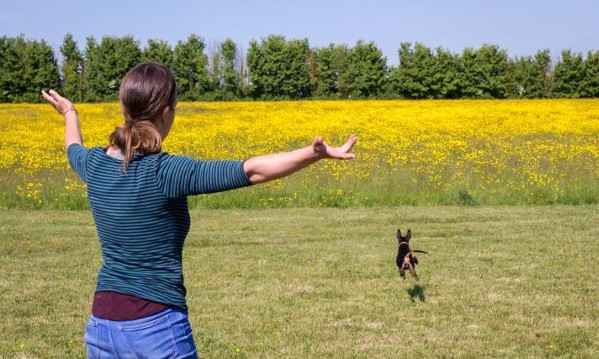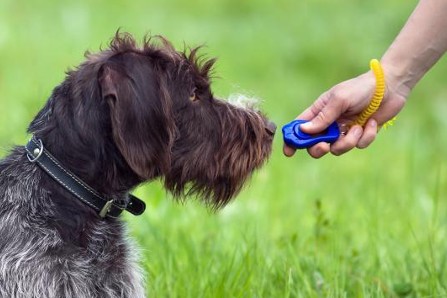CANINE CORNER WITH REBECCA HAWKINS
TIPS FOR RECALL
Training your dog to recognise their name and respond to recall commands is essential for their safety and strengthens your relationship.
Here are a few tips to help with recall.
1. Begin by consistently using your dog s name to capture their attention. Ensure that everyone in your home uses the same name to avoid confusion.

2. Once your dog reliably acknowledges their name, introduce a recall command such as come” or here.” Combine this verbal cue with a visual signal, like outstretched arms, or use a clicker (see below) to aid their understanding.
3. Use the recall command sparingly. Allow your dog a few seconds to respond before repeating the command, and
refrain from calling again if you believe they may not return.
4. Start training in a safe environment, such as indoors or a field. If you cannot be sure your dog will return it is imperative to use a long line until your dog knows the cue. When your
dog approaches you, promptly reward them with treats
and verbal praise, using an excited tone and open body language.

5. As your dog becomes more adept at returning, gradually increase the distance between you and introduce various distractions. Utilise the long line for safety during these training sessions. Use a line without a handle, to avoid your dog getting snagged on branches, you can step on the line if you anticipate your dog wandering too far.
6. If your dog fails to respond, stay calm and avoid showing frustration. Instead, you can gently guide them back with the long line or approach them directly.
7. At first, offer a treat every time they return. Try to keep high value treats such as chicken or sausage just for recall, they will be more keen to return if you have tasty treats. As they improve, you can lessen the frequency of treats but continue to reward them occasionally to keep their motivation high (dogs remember treats so will anticipate a treat even if it only arrives occasionally).
TIPS FOR CLICKER TRAINING

Clicker training is an effective method for dog owners to 'mark' positive behaviours. A clicker is a small plastic device that makes a distinct 'click' sound when pressed, helping dogs associate the sound with rewards. This encourages them to repeat the actions they were performing at the time of the click.
While using a clicker requires having it on hand, it clarifies desired behaviours and shifts your focus to what your dog does right, making the training experience more enjoyable and less frustrating.
There are two main methods for using the clicker. The first is to wait for your dog to naturally show a behaviour you can 'click' to reinforce, which can help with behavioural issues. The second method involves guiding your dog to perform a specific action, such as recall or avoiding distractions, marking it with a 'click' and reward. Gradually reduce your guidance while continuing to click for correct behaviours, which leads to quicker results.
Timing is essential, as the click serves as a reward signal. Always provide a reward immediately after each 'click'. Initially, click often for small successes, and as your dog improves, ask for more effort before clicking. For instance, when teaching down click when they lay down, then wait for them to stay down for a set time.
I have this down to a tee now, I can be out with 6 dogs and as soon as they hear the click they all come running!